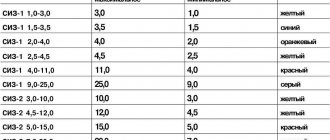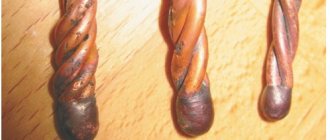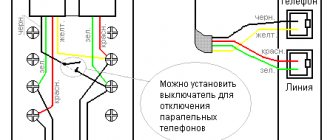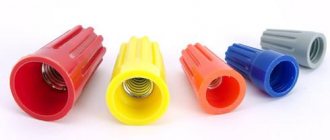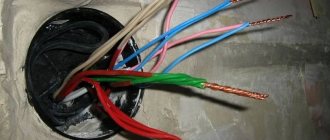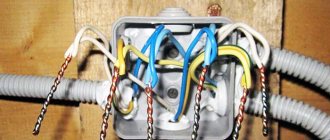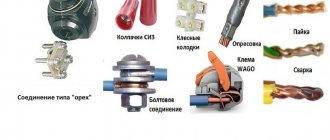Why is twisting wires prohibited?
If you follow everything that is written in the PUE, then according to paragraph 2.1.21, ordinary twisting of wires is strictly prohibited. The connection of conductors is carried out in one of the following ways, namely: welding, soldering, crimping or bolting.
However, earlier, and even now, you can find twisted wires. Moreover, wires are twisted from “assorted” metals, copper and aluminum. All this leads to their oxidation and burning in the future.
A common method is groove twisting
First, familiarize yourself with the sequence of steps on how to twist wires with your own hands. Bend the ends of the wire into small hooks, hook them together, and wind one wire around the other.
Professionals say that these types of wire twisting can be made more durable by using the following recommendations:
Twisted contacts are additionally connected by soldering or welding, as a result the contact acquires maximum reliability and is almost impossible to break. It is preferable to use soldering when both wires of the connection have a large cross-section.
WAGO terminals greatly facilitate connection, making it more efficient; they are needed when you have to figure out how to twist copper wires with aluminum ones. The whole procedure will take place quite quickly, while the “vags” allow you to connect wires of different cross-sections, the contact will be reliable and durable.
If a home handyman is faced with the task of connecting wires in an electrical outlet or lamp, use WAGO terminal blocks.
Thanks to PPE clamps, the reliability of the connection increases significantly, making it as safe as possible. These products have a low price, so they are available at any electrical store.
Wires twisted together should not be immediately closed using a junction box. It is better to observe how the electrical network works for several hours, after which it is recommended to check the temperature at the mounting location. If the connection gets very hot, you need to do everything again: most likely, the contacts are unreliable.
The twist itself is not waterproof, so it is better to take a box to connect the wires inside the wall; if without it, then the twist wires will need to be insulated using cambrics.
All you have to do is determine for yourself which twisting method is better and consider methods for isolating nodes.
Is it possible to twist copper and aluminum?
To the question of whether it is possible to twist a copper wire with an aluminum one, the answer is clearly negative, for two reasons:
- corrosion. Different metals in the contact zone are always destroyed due to corrosion, electrolytic or atmospheric. The rate of destruction for each combination is different and in some cases it is relatively low. But there are pairs of metals, upon contact of which corrosion occurs especially intensely. The combination “aluminum - copper” belongs to this group. As a result of chemical changes, the conductivity of metals drops sharply and the connection heats up;
- difference in coefficient of thermal expansion. Because of it, heating-cooling cycles will lead to weakening of the twist and, as a result, deterioration of the contact.
There must be an intermediary between aluminum and copper - brass or galvanized steel; to connect such conductors the following is used:
- terminal blocks: wires are inserted into different terminals;
- sleeves for crimping of the GAM brand (half is made of aluminum, the other is copper);
- soldering using special solder and flux;
- bolt clamp with a galvanized washer between the aluminum and copper conductors.
Sequence of actions when using bolt clamps:
- put a washer on a small diameter bolt or screw;
- twist the end of one strand into a ring and put it on next;
- put on a galvanized washer;
- twist the second core into a ring and also put it on;
- use another washer and tighten the connection with a nut.
Contact of aluminum with tinned copper is also allowed.
In air, aluminum quickly becomes covered with an oxide film with high resistivity, to avoid which the ends of the cores of this metal are lubricated with quartz-vaseline paste before making the connection. This paste is added to terminals and connecting insulating clips (PIC) for aluminum wires at the production stage.
General rules for switching electrical cables in distribution boxes
Of course, all requirements for energy supply are set out in the PUE.
This is an electrician's reference book. Moreover, there are fines for violating the Electrical Installation Rules. However, in practice, all these strictures apply only to institutions and organizations. In private households, responsibility ends with the wire coming out of the meter (electricity meter). The rest is up to the homeowner. To prevent an incorrect connection from leading to a fire or electric shock, you must follow simple rules:
- The connection of wires in the junction box is made during a complete power outage. Even if the electrician is wearing dielectric gloves and is familiar with safety rules, accidental contact of the phase wire with structural elements of the building or grounding is possible.
- The type of connection must be the same for each line within the same box. This will protect your line from loosening under load.
- Physical contact of conductors made of different materials (copper with aluminum) is not allowed. When electric current flows, active electrocorrosion occurs. Metals are coated with an oxide film, which impairs contact. The result is sparking, overheating, and complete burnout of the contact connection. If such a need arises, it is necessary to tin the wires using solder. After twisting, the connection must be soldered for at least 50% of the length. The rest of the strand will not corrode because no current flows through it under load.
- It is necessary to exclude the possibility of exposed conductors leaving the box. Even if the cable is completely laid in the wall.
- When connecting without contact devices, that is, using soldering, twisting or welding, an insulating cap must be placed on the exposed conductor. The insulator must be firmly fixed; non-combustible materials are used in its manufacture.
- The ends of the wires inside the box must have at least a 200% margin along the length of the connecting ends. In the event of a break or burnout, it will be possible to re-install without laying a new wire.
In addition, inexperienced electricians often make mistakes and break off wires when stripping the insulation. If the wire is inserted into the box under tension, reconnection will be impossible.
Connecting wires in electrical junction boxes
It probably goes without saying that junction boxes for building electrical wiring are an integral part of the electrical circuit.
And all the same, it would be useful to recall once again that electrical distribution boxes are special plastic containers that have a rectangular or round shape and are closed with a lid made of the same plastic.
Their main purpose is switching, that is, connecting sections (loops) of electrical wiring in one place.
It is clear that electricity is supplied to consumers through wires that connect them to the distribution board. In this case, the main requirement of wiring is the uniform distribution of current among consumers, and, accordingly, among sections.
Therefore, in each room there are several sections that supply a group or individual electricity consumers. And since there are several sections, this means that they must be connected somewhere. It is in this place that the distribution box is installed.
It is in them that the wires are connected.
But experts say that this is not the main purpose of electrical junction boxes. The basis of their installation is, oddly enough, the fire safety of the operation of the electrical circuit of the building, and, accordingly, the entire structure itself.
It should be noted that the connection of wires in the entire wiring is considered the most unreliable place. Often the strands heat up and the insulation burns, which sometimes leads to fires and fires.
So, the distribution box is a kind of protective barrier that meets fire safety requirements. Well, plus a secondary function, which is also important, is the aesthetic side of the matter.
Let's face it, open twists or terminal elements on the wall are an unpresentable appearance.
As for the standard range of distribution boxes, there are only two of them:
- Internal, used for internal wiring. This electrical distribution box is installed in the wall, only its cover is visible from the outside.
- Invoices. Such devices are mounted on top of the wall and are used for open electrical wiring.
Connecting three wires of different sections using screw terminals
Three wires of different thicknesses can be reliably connected to each other using special ZVI screw clamps. The clamps have a very convenient design and allow you to create contact between cables that have different cross-sections. The strength of the connection is achieved by using separate screws for each clamp.
You need to select ZVI clamps taking into account the cross-section of the wires that will be connected, as well as their current load. For reliable contact, it is recommended to connect three wires of adjacent sections. Let us conventionally designate the cross-section of the connected conductors as SPP, and the permissible long-term current as DDT. Below are the parameters of clamps and wires:
- ZVI-3 – SPP 1 – 2.5; DDT – 3;
- ZVI-5 – SPP 1.5 – 4; DDT – 5;
- ZVI-10 – SPP 2.5 – 6; DDT - 10;
- ZVI-15 – SPP 4 – 10; DDT - 15;
- ZVI-20 – SPP 4 – 10; DDT - 20;
- ZVI-30 – SPP 6 – 16; DDT - 30;
- ZVI-60 – SPP 6 – 16; DDT - 60;
- ZVI-80 – SPP 10 – 25; DDT - 80;
- ZVI-100 – SPP 10 – 25; DDT - 100;
- ZVI-150 – SPP 16 – 35; DDT - 150.
With the right choice of screw clamp, you can create a truly reliable connection that will ensure uninterrupted operation of the electrical network.
detailed instructions
First, let's consider the simplest option, when it is necessary to connect two single-core conductors of the same metal (for example, copper).
The technology looks like this:
- We carefully strip both cores of insulation to about 5 cm. You can also use a special tool for removing insulation for this.
- We clean the exposed veins to a metallic shine with a knife or sandpaper.
- We cross the two wires and twist them clockwise together so that they wrap around each other in a spiral (see diagram below).
- We insulate the finished twist using electrical tape. It is also recommended to use heat-shrink tubing, which reliably protects the exposed area from the external environment.
As you can see, there is nothing complicated. The peculiarity is that it is necessary to expose the veins by at least 5 cm and twist them with pliers so that there is continuous and reliable contact.
I would also like to give a couple of tips about a more complex situation when it is necessary to twist single-core and stranded wire. In this case, first repeat points “1” and “2” from the instructions provided above. Next, you need to cross the products and carefully wind the stranded wire around the middle of the single-core wire (at a distance of 2.5 cm from the end). When all the turns are wound, the free end of the single-core conductor must be bent with pliers towards the turns, as shown in the photo below. After this, the connection is insulated and placed in the junction box. By the way, in the same way you can make a good twist of two stranded wires.
You should draw your attention to the fact that it is forbidden to twist aluminum and copper under any circumstances. The first and main reason is that a galvanic couple is formed between aluminum and copper; as a result of chemical reactions, when moisture enters (it will be there in any case), electrolysis begins and the connection is destroyed
The contact resistance increases until it disappears completely, at which time it begins to heat up and burn. With direct current, such a connection will be destroyed especially quickly.
The first and main reason is that a galvanic couple is formed between aluminum and copper; as a result of chemical reactions, when moisture enters (it will be there in any case), electrolysis begins and the connection is destroyed. The contact resistance increases until it disappears completely, at which time it begins to heat up and burn. With direct current, such a connection will be destroyed especially quickly.
The second reason is that copper and aluminum have different coefficients of thermal expansion; under load, when the contact heats up, the conductors will expand “differently,” and after cooling, the twist will weaken and the resistance will increase even more - like a snowball.
The third reason is that an oxide protective film always forms on the surface of aluminum, which also increases the contact resistance, therefore, to connect aluminum wires, they are coated with quartz vaseline paste, and terminal blocks for them are sold already filled with this paste.
These are the diagrams you can use when twisting wires with your own hands:
We also advise you to watch the visual instructions:
An interesting device will allow you to quickly fasten:
How to twist it with your own hands?
Usually in everyday life, when reorganizing the wiring, the home handyman is faced with the question of how to properly twist the wires in the junction box. In this regard, each of the listed methods is worth considering in detail.
Parallel
They operate in this order:
at a distance of 7-8 cm from the end of each core, cut the insulation and remove it
It is important not to damage the core itself, otherwise it will break off when twisted. If a regular knife is used, the incision is made obliquely, directing the blade almost along the conductor
The latter is rolled with a finger on the table. It is more correct to use a special tool - a stripper or an electrician's knife with a heel. Such a tool is physically unable to make a deep cut in the insulation, so that the core is guaranteed to remain undamaged; clean the wires to a metallic shine with sandpaper; fold the wires crosswise where the insulation ends; holding the wires at the intersection point with some pliers, twist them into a tight bundle with the other. To avoid damaging the insulation with the tool, they are wrapped with electrical tape; with wire cutters they cut off the ends of the veins sticking out to the sides, making the same twisting movement; isolate the connection (insulation methods are described below).
The recommended twist length is 15 core diameters. The minimum permissible length is 10 diameters.
It is inconvenient to grab thin wires with pliers; they are twisted by hand. To do this, they are folded in parallel, and the ends are bent so that you can grasp them with your fingers.
Sequential
Consecutive twisting exceeds the previous one in strength, order of execution:
- the bare and stripped veins are folded crosswise, so that the intersection point falls in the middle of the bare area;
- The 1st wire is wound onto the 2nd, moving from the intersection point to the insulation;
- The 2nd wire is wound on the 1st according to the same scheme.
This method can withstand tensile forces better than the parallel method. This option is also more preferable for circuits subject to vibration, for example in a car.
Twisting in automotive wiring is used only as a short-term temporary option. Permanent connections here are made using crimp sleeves.
Bandage
The bandage method is implemented like this:
- the connected conductors are applied one to the other in parallel;
- tightly wrap a piece of wire around them (you must use a fairly flexible one);
- isolate the connection.
Before insulating the twist, it is recommended to check it. Having connected the load, use the line for several hours, and then, making sure to de-energize it through the circuit breaker, check the twisting temperature. If it is hot, the contact is bad, the connection is redone. In this case, the ends of the strands are bitten off - they cannot be twisted again.
Safety precautions: before touching bare wires with your hands, you should always check the absence of voltage with a phase indicator.
Types of twists and connections of this type
One of the advantages of such a connection as twisting is the possibility of improving it by soldering or welding. When soldering, the connection becomes strong and is able to withstand high currents; when welding, special equipment is used, which makes it possible to give strength to the completed connection. Soldering and welding of both copper and aluminum wires is an excellent way to improve its performance: reduce the thermal load by improving contact at the welding or soldering points.
When carrying out work, twists can be divided into several types depending on the materials, type of wire, type of twist
It is extremely important that the cross-sectional area of each of the conductors matches each other, and is also suitable for the load used
Conductors can be made of the following materials:
- aluminum;
- copper.
Aluminum braiding is less resistant to further unwinding, while copper conductors can be unbraided and rebraided several times, for example, to add a third contact. Aluminum can withstand 1-2 times the load of twisting and unwinding, copper can be twisted and untwisted 3-4 times without any damage.
In this case, conductors can be divided into 2 types:
- with a monolithic core;
- stranded.
When performing the twisting process, it is worth considering the type of conductor, since the options for the plexus may be different. Depending on the type of wire, one or another twisting method should be used.
A cord with a monolithic core is usually used for stationary wiring, when there is no need to move equipment. Stranded conductors are often used for “rough” installation or where there is a need to move devices.
The twisting of both copper wires and aluminum wires is the same and is shown in the tables for each type of cord (stranded/single-core). If it is necessary to weave more than two conductors, for example 3-4, then first the initial twisting is performed for the two ends (shaping the connection) - 1-2 turns, after which the required number of conductors is added and twisted according to one pattern or another.
Soldering iron to help
In addition to twisting, soldering is used at the joints. This method is used in places of high humidity, where the requirements for resistance of wires to oxidation are most important. The pre-made twist is melted with rosin, after which solder is applied to it
At the same time, the power of a regular household soldering iron is sufficient; it is important to prevent the formation of sharp burrs on the solder. After drying, they are removed with a needle file, because
there is a risk of damage to the insulation.
The use of solder helps to connect thin stranded wires that are twisted together. The contact surface after processing with a soldering iron increases, therefore, the contact area of the connections becomes larger. It is worth considering that the load on the connected wires, regardless of the use of soldering, is calculated based on the cross-section of the smallest of them.
Characteristics
The technical characteristics of the wire make it possible to successfully use VVG and its varieties (AVVG, VVGng, VVGp, etc.) under various installation conditions. GOST 16442 establishes the following characteristics:
- Rated voltage 0.66-1 kV in accordance with the insulation class.
- Operating temperature from -50/+50 degrees. When laying outdoors, provide protection from UV radiation. At -15 degrees. installation requires heating.
- The maximum temperature that the wiring can withstand without loss of functionality is 70 degrees. In short circuit mode (no more than 4 seconds) - 160 degrees.
- The maximum bend is determined by the type of core. For solid ones, it is equal to ten times the diameter; for multi-wire ones, a coefficient of 7.5 is used.
- VVG is supplied in coils. The footage depends on the cross-section of the cores and can be 450 m, 300 m and 200 m.
- The average product life is 30 years, and the warranty period is 5 years.
Secrets of choice
When arranging their home, many people wonder which VVG wire is best to choose. Professionals recommend using a cable with a cross-section of 1.5 sq. mm for standard lighting devices, and 2.5 sq. mm for sockets.
When purchasing, be sure to pay attention to smudges - a high-quality product has an even cut, the shell fits tightly to the cores
It is important to focus on reputable manufacturers - “Energokabel” (Electrougli), LLC “Rybinskkabel” (city
Rybinsk), "MosKabelMet" (Moscow).
Elektrougli), Rybinskkabel LLC (Rybinsk), MosKabelMet (Moscow).
\
Twist
You can make a twist in one of three ways:
- simple twist;
- bandage;
- twisting with a groove.
The first method is most often used in everyday life. The correct choice of tool and the use of PPE caps allows for good contact.
This method is used to connect the ends in the junction box.
Band twisting is used to make connections for large diameter wires. To ensure a strong connection of aluminum cores, groove twisting is used.
If the connection technology in the junction box is carried out accurately, then the contact can serve for a long time and reliably.
All of the listed types of twisting require a certain skill in operation.
Using these methods, it is recommended to connect wires with a cross-section of up to 10 squares. The distribution box of a household circuit uses wires with a cross-section of 1.5 - 2.5 square.
When the wire cross-section is 6 square meters or higher, PPE caps are not used in the junction box.
To strengthen the bandage twist, soldering is used. Technological instructions do not allow simple twisting of aluminum and copper wires.
Such connections can be made after preliminary tinning of the copper.
All of the above methods are used to connect multi-core cables and wires. All operations in the junction box must be done carefully. Especially in the case when there are more than three cores in the cable.
When performing such work, it is recommended to use caps for twisting wires. Before starting, you need to sand the ends of the wire with sandpaper.
If it is necessary to make an additional tap on a certain section of the line, then all actions are performed according to a standard and familiar scheme.
To reliably twist aluminum wires, an electrician requires theoretical training and practical skills.
With enough experience, he can quickly complete any connection. In this case, the place of twisting must be cleaned. Aluminum oxide has insulating properties.
If the contact at the twisting point gets hot, then most likely the stripping of the aluminum wire was not done properly. It's no secret that all operations need to be done correctly.
This law strictly applies in electrical engineering. The fitter must have good tools and an exam on the rules of operating electrical installations - he must pass it within a certain time frame.
Features of twisting single-core wires
Technique for removing insulation from wiring
To twist single-core wires tightly and correctly, a parallel connection is suitable. When performing work you must:
- remove insulation at an angle of less than 90 degrees;
- act carefully if the cable material is aluminum;
- strip the insulation for the connection to a length of 3-4 cm;
- lay two cables on top of each other 1.5-2 cm above the bare area at an angle of 45 degrees;
- holding the area above the cut with your left hand, begin to twist the veins;
- work so that first there is a twist with insulation, and then a bare section;
- finish the twisting process with pliers for additional density.
The finished twist does not need to be covered with insulation right away. The line should operate for 2-3 hours. After this, you need to turn off the machine at the input and check the temperature of the node. Heating indicates that the fastening is unreliable - it will need to be redone. In the absence of heating, the conductors can be insulated.
To ensure reliable twisting
To ensure maximum contact between the conductors, you need to ensure that they are in close and strong contact with each other. The spring that is built into the clamp enhances this effect. However, it should be taken into account that the metal spring has its own fatigue threshold, and over time the pressure will weaken and contact will gradually begin to be lost. Also, the bare surfaces of conductors are constantly in contact with air, due to which an oxide film and rust inevitably form on them. These factors will decrease conductivity with increasing intensity. Therefore, for greater reliability and durability of the connection, the use of PPE should be combined with other insulation methods; the reverse is prohibited by the PUE.
Advantages
- easy to install, saves a lot of time;
- do not require additional tools and skills;
- The durable cap simultaneously insulates and protects the connected wires;
- does not require a large amount of additional materials;
- the result is a practical and convenient connection; if necessary, the cap can be twisted and the wires disconnected, or the connection can be remade;
- high-quality PPE can withstand temperatures from –40 to +105 degrees Celsius.
Flaws
- you need to ensure that the size of the clamp matches the cross-section of the cable;
- It is not recommended to use for installing a street line;
- It is allowed to connect only copper electrical wires, caps for aluminum cables must be with anti-oxide paste;
- It is not recommended to use the PPE compound in its pure form.
Connection isolation
An important requirement in the connection procedure is their isolation to avoid accidents. Insulating materials include:
- PVC tubes;
- insulating tape;
- heat shrink tubes;
- special twist insulator caps.
Wire insulation methods
Methods of insulating wires directly depend on the material used. They are divided into methods such as planting, reeling and heating. In the first case, the material is placed on the twisted segment. In the second, simple winding is performed using insulating tape. In the third, insulation with a heat-shrinkable tube involves placing it on the current-carrying part and then heating it.
To the question of beginners, “Is it possible to insulate wires with electrical tape?” should be answered unequivocally in the affirmative. This is one of the most common methods. The main requirement is compliance with the shelf life of the material and the absence of visible damage.
Despite the fact that at first glance the procedure for twisting electrically conductive wires seems simple, a responsible approach to the matter is required.
One-piece crimping
For twisting stranded wires, special permanent crimp connections are used. This connection method should be used for identical metals, since due to the difference in resistance in each crimp, contact, for example, of copper with aluminum will lead to heating. If the twist is made of copper wires, this should also be the connecting tube, the diameter of which approximately corresponds to the thickness of the connected wires. Pre-twisting of the wires is not necessary.
The cables inserted into the tube are crimped with press pliers on both sides. At least three layers of insulating material are applied to the resulting joint. As an alternative to insulating tape, you can use ready-made crimps with an insulating cap. Such a tube is crimped immediately with a polyethylene cap, which gently deforms and reliably isolates the joint.
Modern materials
Manufacturers of electrical installations offer their solutions to the issue of connecting wires. Factory-made compact connectors are a modern alternative to twisted cables. For example, PPE clamps for twisting are a cone-shaped spring installed in a dielectric housing. The caps and bundles of wires inserted into such PPE are twisted several turns and securely fixed.
For quick connections, “Wago” terminals from the same manufacturer are suitable. The joint in them occurs automatically: when the core is inserted into the corresponding hole, a flat-spring clamp is triggered. Such terminals can be disposable or reusable. Due to ease of use, wiring is easy and contact is reliable.
Don't forget the standard terminal blocks, which are universal for all types of connections. Made using a block, the connection is as good as either Wago or PPE caps.
Where does the wiring start?
A route for its installation is being thought out, which will help carry out repair work if a wire burns out somewhere, without breaking the walls or destroying the decorations of the room.
To do this, you can use pipes or structures for wiring, although in most cases a small area of the wall is knocked out and wiring is laid there - then it is covered with putty or even cement. In principle, this is the simplest method and it is often used.
But what is most important is the wiring diagram, as it will help during the installation process and reliable operation after its completion. Due to it, the correct load on the network will be ensured and the locations of sockets, electrical boxes, and switches will be formed.
If you have knowledge in this area, then this is a simple matter that will not take much time. But in case of their absence, even taking into account an explanation of how this is done, it is advisable to turn to specialists and, based on this information, monitor their work.
Otherwise, unexpected troubles may arise - electric shock, short circuit and burnout of wires, damage to household appliances.
In fact, installing electrical wiring yourself is not an easy task, and as you understand, we do not recommend doing this without the appropriate skills. The fact is that if you don’t know how to do this, it’s better to protect yourself and your loved ones by turning to specialists.
This applies not only to the organization of wiring, but also to simple repairs, if the lights suddenly went out and there was no apparent reason, or you saw a fire or smelled something burning. Any action without knowledge of electricity can cause significant harm.
Types of twists
Types of twists
By twisting the wires correctly, you can get a reliable and dense section. Craftsmen resort to various types of connections - safe and durable:
- Bandage - an additional one is applied to two sections and braided around them. This creates additional reinforcement of the area.
- Groove - with the parallel technique, one core remains motionless, and the second wraps around it. This type involves making 3-4 turns of one cable around the second. Then the first one is laid tightly parallel to the second one and 3-4 turns are made again;
- parallel connection. Two conductors with the insulation removed at the same level are laid side by side. The tips cross tightly and twist in any direction.
Options for twisting stranded wires
A stranded wire is a wire with a metal central part in the form of thin wires. The elements are intertwined with each other, forming a lay with external insulation. Manufacturers can coat the wiring with polyurethane and add nylon threads to improve strength. The protection complicates the process of removing the insulating layer.
Twisting of insulated stranded wires is performed in several ways.
Parallel connection
The simplest option is when two stripped wires are laid crosswise, one on top of the other. Only the area without insulation is allowed to twist. Parallel twisting ensures reliable contacts, but does not protect against forceful breaks.
The technology is suitable for copper conductors - one monolithic and one stranded. Aluminum conductors with different cross-sections can also be connected in parallel. In the case of a monolithic wire, you will need to remove more insulation than from a stranded wire.
After twisting, there should be a segment left from which an additional bend is created in the direction of fixation. This technique increases the strength of the connection.
In parallel, you can fix more than 2 wires.
Sequential seam type
You need to fasten the wires together so that each of them overlaps the other:
- the conductors are stripped of the insulating coating;
- the stripped elements are stacked on top of each other;
- twisting begins from the center so that one wire wraps around the second;
- The second contact is screwed in the same way.
Due to minimal reliability, the connection is suitable for two cables.
Bandage twist
The best way to fasten a stranded wire:
- two types of wire are selected - hard for fixing and soft for winding;
- the insulation is removed from the cores so that the length of the exposed areas is the same;
- conductors are laid in parallel;
- to fix the cores together, a third stripped wire is used.
For twisted products, you need to choose more than 2 rigid cables. Winding is organized using a flexible soft wire.
Types of twists
Reliable and tight twisting protects against unforeseen emergency situations
It is important to do it as correctly as possible. Even the slightest violation of safety regulations can cause a fire.
For this reason, the rules for the design of electrical equipment do not provide for the legal use of this method. Despite the ban, it is relevant both in production and in everyday life. Existing types of wire twists can be used temporarily when, for some reason, a quick connection using safer methods is not possible.
There are simple methods by which the connection can be made safely and firmly. They are not difficult even for a beginner. When performing, it is possible to use both two wires and several. The following known types of twists are usually used:
- bandage;
- groove;
- simple branching method.
Types of wire twists
The above twisted electrical wires are completely reliable electrical connections. But implementation requires certain skills with hand tools. Self-training is available to every person who practices repairing electrical wires.
Bandage is one of the methods of twisting wires, often used in everyday life. It is characterized by the use of an additional segment, which is superimposed on the connected conductors. This is a good method for serial, parallel and branch connections.
Stranded
Beginners sometimes wonder: “how to connect single-core and stranded copper wire?” In fact, the main requirement is a tight and reliable fit of the cross-sectional area of the cores to each other. Knowing how many wires can be twisted into one twist, you can quickly complete the task. The number of electrical conductors depends on their cross-section. The larger it is, the fewer wires are allowed to twist. And vice versa: the smaller the cross-section of the conductive wires, the greater the number of wires that can be twisted.
Connecting stranded wires using the groove method is not difficult. This is an easier way to do the job than the “bandage”. In this connection, it is not necessary to use an additional piece of wiring. In this case, a complete connection of wires by twisting is carried out directly by the wires themselves. They are laid in parallel, in series or in a branch.
Before twisting the three wires together, it is necessary to remove the insulation from the ends of the wires and use a hand tool to twist them. It is permissible to use the “groove” and “bandage” methods, as well as a simple branch. The maximum number of wires in a twist using the latter method depends on the diameter of the conductor. Even with the smallest diameter of the cores, their number should not be more than six. Novice electricians are wondering: “how to make a twist of 4 wires?” It is most optimal to perform this action using the “groove” or “simple branch” method.
Advantages and disadvantages
Using twisting, you can quickly connect wires.
The interweaving of conductors is not designed for connecting powerful appliances - kettles, washing machines, heaters, refrigerators, computers. Despite this, twisting has several advantages:
- fast organization process;
- if performed correctly - durability;
- no need for special tools;
- creation of signal contacts;
- additional reinforcement when using soldering technology;
- minimum costs for consumables;
- possibility of re-execution.
Among the disadvantages are:
- mandatory insulation of the twisted section;
- normal line operation only when connecting low-power consumers;
- inconvenience of implementation;
- risks of wiring fire if the algorithm is violated;
- constant voltage drops and overload of the twisted section.
Plexus is advisable when using low-power equipment - lamps, power adapters.
Nuances
Connecting conductors from different materials
The most basic thing is that twisting is PROHIBITED with conductors made of different materials. It is PROHIBITED to weave copper and aluminum wires. This is due to the fact that when copper and aluminum come into contact, a galvanic couple appears, which destroys the created connection. The higher the current passing through the plexus, the faster its destruction will occur. Such contact of wires threatens with the following consequences:
- heating, sparking and subsequent combustion;
- deterioration in the quality of contact of such a “weave”;
- reducing the contact area;
- strong heating of the wires at the plexus;
- rapid oxidation;
- under temporary and powerful loads, “heating-cooling” cycles occur, which is fraught with severe
- deterioration in connection quality.
The appearance of an oxide film
The film appears as a result of the interaction between the oxygen environment of the air and the conductor. The metal conductors used to make connections are usually made of aluminum or copper and are quite susceptible to oxide film if the connection is not insulated. More expensive materials that are rarely used in electrical circuits, such as gold and platinum, do not have this disadvantage, but their cost is extremely high. An oxide film on wires has the following consequences:
- deterioration in the quality of twist contact;
- intensification of the heating process when current passes.
Dealing with this drawback is quite simple - it is necessary to carry out high-quality insulation of the twist.
The appearance of transient contact resistance
This resistance appears as a result of poor contact between the wires, which causes the temperature to increase greatly at the point where the current passes from one part to another. Transient contact resistance serves as a catalyst for the rapid destruction of the wire tangle, especially in the absence of insulation. To minimize transient contact resistance, the tightest contact between the two conductors should be made.
Twisting wires together according to the PUE
Twisting in its pure form, that is, when the wires wrap around each other without additional fixation, is prohibited according to the PUE. The reason is that, due to the elasticity of the metal and due to repeated heating-cooling cycles, the contact gradually weakens, which means the contact resistance increases.
In the old days, when the list of electrical receivers in an apartment was limited to a TV, lighting and a low-power iron, this was not a threat, so twisting was used everywhere.
With the advent of water heaters, multicookers and other powerful equipment in everyday use, the strength of the current flowing in home wiring has increased significantly, and under such conditions, an area with even low resistance quickly heats up to the point where the insulation melts or ignites.
Nevertheless, every electrician must be able to twist correctly, since for high-quality welding or soldering of wires they must first be twisted. In addition, twisting can be useful as a temporary method if you do not have a terminal block or other clamp at hand.
Installation
In practice, two methods are used for twisting wires using PPE caps. First method: without preliminary twisting. Second method: with preliminary twisting.
Pre-twisted installation
Often in practice, electricians install PPE on a pre-prepared twist of bare wires. To do this, you need to take the stripped wires and press them tightly against each other. The bundle should be fixed using pliers, stepping back a couple of millimeters from the exposed veins. In this case, you need to start twisting the bare ends of the electrical wires pressed against each other clockwise. For twisting, it is best to use another pliers. A small section can be twisted by hand, but if the wires are thick or there are many of them, then use a tool. Once twisting is complete, bite off the remaining exposed wire at a sharp angle.
Installation without twisting
PPE is installed on electrical wires without twisting (a more popular practice). To do this, you need to place the bare wires parallel so that the ends point in the same direction, insert the ends into the PPE and start screwing the cap manually (clockwise). Manual screwing must be done until the spring clicks. A click from the spring will indicate that the twist within the cap has been completed. Further, if the length of the bare wire does not extend beyond the clamp, then the work is finished.
Some electricians recommend exposing a longer section of cable to make the twist longer and more secure. In this case, it will extend beyond the cap, and after a spring click, you will need to tighten the connection using pliers or a screwdriver until the entire bundle of wires is twisted all the way to the insulating coating. After this, the exposed area must be insulated. The best way to do this is with heat shrink tubing and electrical tape.
It is also important that the conductors transmit current through the connection and not through the clamp spring. Since the spring is not predisposed to such loads, it will very quickly overheat and fail
Do not connect cables made of different metals
You also need to know that you cannot twist a combination of copper and aluminum cables together. Since in such cases, special devices (pads) with built-in metal adapters are used.
The process of preparing veins for twisting
Stripping the insulation
To twist the electrical wires, you will need to de-energize the network by turning off the input circuit breaker. Next you will need:
- choose a tool with insulated handles and gloves made of dielectric material;
- remove the insulating coating from the conductors so that the metal part remains intact;
- soak a cloth in any degreaser (white spirit, acetone, nail polish remover) and wipe off the exposed parts;
- Use sandpaper to clean the area of the core so that it acquires a characteristic metallic sheen.
Twisting can begin only after preparation.
